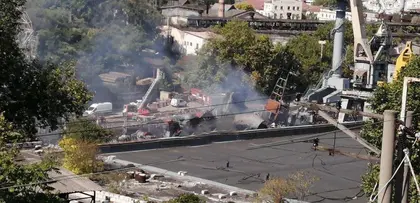The damage to Russia from Wednesday’s cruise missile strike in occupied Crimea will significantly hinder the Kremlin’s ability to project naval force into the Black Sea.
Official Russian sources and uncensored social media have suggest that Ukrainian Storm Shadow missiles dropped by Ukrainian attack jets slammed into the Kremlin-controlled Sevastopol Shipyard in the early morning hours.
- View the newest war in ukraine update in the Kyiv Post’s daily news stories that came out today.
- Examine the most contemporary Ukraine news that came out today.
JOIN US ON TELEGRAM
Follow our coverage of the war on the @Kyivpost_official.
Multiple Russian social media videos showed at least two explosions, followed by rolling balls of orange fire and gray smoke, seeming to erupt at the military base’s third dry dock, about 200 meters to the west, during the early-morning strike.
Russian official statements identified two warships as “damaged”: the Rostov-Na-Danu, a Kilo-class submarine, and the Minsk, a Ropucha-class amphibious assault vessel.
A Ukrainian intelligence source told Kyiv Post it was a “very good result” for Ukraine.
Additional footage of the already burning Sevastopol Shipyard drydocks taking another Ukrainian missile hit earlier this morning. pic.twitter.com/XMuGwDmkpQ
— OSINTtechnical (@Osinttechnical) September 13, 2023
It was not clear whether either the submarine or the amphibious assault vessel would be able to exit the dry dock under their own power, or if tugboats would be needed. Both reportedly caught fire as a result of the strike. Social media from Sevastopol by midday Wednesday widely documented continuing fires and smoke rising from the general location where the two ships were tied up.
The third dry dock could possibly take even more time to return to functionality, because it was dry and empty at the time of the strikes, and its structural integrity is questionable, at minimum, and quite possibly compromised for some time. Two 150-kg Storm Shadow high explosive warheads designed to punch through ship armor and blow up, appear to have hit the dry dock’s steel frame and detonated.

Ukraine Targets Key Russian Rocket Fuel Plant with ATACMS and Storm Shadow Missiles
The Russian navy has kept silent about the extent of the damage to the warships and not referred to the third dry dock beyond admitting that “port facilities at the Ordzhonikidze Ship Repair Factory (the state company operating all three dry docks) were damaged.”
Russia’s battered reputation
The Ukrainian missile strikes have created a logistics and naval support crisis for Russian Black Sea Fleet (BSF) commanders that could last for up to a month. Until the two jammed dry docks are cleared and the third damaged dry dock is returned to working order, BSF command will have no choice but to shift any necessary repair work to the less capable and overloaded naval base in Novorossiysk, in Russia’s Kuban region.
A smaller and less-capable military facility than Sevastopol, the Novorossiysk base lacks dry docks, recent open-source satellite imagery showed. Although the Russian navy has used civilian-operated floating dry docks in the past to repair its warships, the Ukrainian strike on Sevastopol has, at least for the short term, left the BSF with no easy way to make major repairs on any of its warships, if the vessel is seriously damaged below the waterline.
Apparently, the damage done to 🇷🇺 large amphibious ship “Minsk” & the “Rostov-na-Donu” submarine in the occupied Crimea last night is irreparable.
— olexander scherba🇺🇦 (@olex_scherba) September 13, 2023
Picture shows what remained of “Minsk”. #StandWithUkraine pic.twitter.com/5viKsXlBoZ
It wasn’t just bad news for the Russian navy. According to the Kremlin, the air space over Crimea in general, and Sevastopol in particular, is some of the best-defended in all the territory Russia controls, overwatched by all manner of hardware touted by Moscow to be the world’s best at dominating the skies: top-end interceptors like the Su-35 (NATO designation Flanker-E) and layers of anti-aircraft systems such as the S-400 (NATO: SA-21 Growler) missiles, the medium-range S-300P (NATO: SA-10 Grumble) missiles and short-range Tor (NATO: SA-16 Gauntlet).
The ten British-French cruise missiles that broke into that network and inflicted serious damage probably did little to improve the international reputation of Russian military hardware and Russian military advisors. Worse for the Kremlin, Ukraine’s strategy of systematically degrading Russian air defenses prior to launching a major strike is evidently working.
An ongoing campaign
On Aug. 23 missiles fired by Ukraine, reportedly launched from the Odesa region, flew across the Black Sea to take out an S-400 battery (designed, among other things, to shoot down cruise missiles) at the west end of the Crimean Peninsula. The next day Ukrainian special operations infantry landed nearby and demolished an air defense radar and, according to some reports, another anti-aircraft missile battery.
By Sept. 5 independent Ukrainian news agencies were reporting Ukrainian long-range Bayraktar strike drones, long unable to operate around Crimea because of powerful Russian air defenses, were trawling air space off the Crimean shore and meeting no Kremlin interference.
On Sept. 11 Ukrainian small boat teams captured a pair of oil rigs in the central Black Sea, which the Russian air force had been using to position early-warning radars.
Two days later, the Ukrainian air force, in what appears to have been the single largest Ukrainian air strike since Russia’s invasion back in February 2022, flew into the teeth of Russian air defenses protecting the Sevastopol port and punched off 10 modern cruise missiles, inflicting the worst air strike on the Black Sea Fleet since the Second World War.
The Ukrainian bombers, most likely Soviet-era Su-24 jets modified to carry a pair of Storm Shadows, all got away scot-free, news reports said.
You can also highlight the text and press Ctrl + Enter






